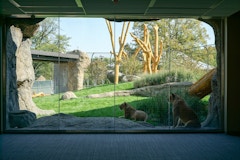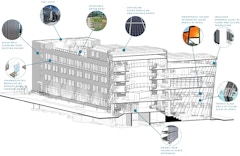BioFacades Classification
Coauthors: Mary Ben Bonham, Department of Architecture + Interior Design, Miami University, Oxford, OH, USA [corresponding] [presenting at the
Coauthors: Mary Ben Bonham, Department of Architecture + Interior Design, Miami University, Oxford, OH, USA [corresponding] [presenting at the
The contemporary renovation of historic buildings often includes all-glass structures that allow architects to preserve the original building design
As we change the rules of thermal performance for facades, we are changing the conditions the glass is subject to in shadow boxes and glazed spandrel
In 2023, the International Sustainability Standards Board (ISSB) inaugurated the first two global sustainability disclosure standards IFRS S1/S2 to
Over the past two decades, the art of cold-forming glass has grown from an unknown approach to a widely accepted strategy for achieving an array of
How has the role of the façade evolved in light of the COVID-19 pandemic and ongoing fight to combat the climate change crisis? As companies grapple
Double Skin Facades (DSF), constructed from individual aluminum framed curtain wall assemblies, provide a means of achieving acoustic and thermal
Responsive shading systems can dynamically improve indoor environmental conditions based on outdoor climate variations. Among the technologies,
This paper describes the development of an interactive map that highlights case studies of advanced facade design strategies and technologies from
The prevalence of fully glazed facades in modern office buildings has been steadily increasing, primarily driven by architects' focus on aesthetic

The Science and Engineering Complex (SEC) on the Allston Campus is the largest new building at Harvard University in recent decades with a footprint

What environmental impact does one object have on the world? This is the question at the core of life cycle assessments (LCA); the embodied carbon lens. ...the current architectural practice rarely provides enough time to explore this type of examination.

This paper will focus on the design and detailing of large-format glass enclosures intended to maximize transparency using state-of-the-art materials

Ever-increasing performance requirements in the latest version of the energy codes are compelling project teams to consider the thermal performance

The historical focus on reducing the carbon footprint of a building has recently shifted to include more emphasis on embodied carbon, the carbon

Life Cycle Assessment (LCA) is a methodology used to quantify the impact of building construction supply chains on the environment in terms of

This paper analyzes sustainable retrofit strategies for an existing research laboratory building, located in a cold climate. This facility is

The recently completed Capital One Hall performing arts center located in the Washington DC metro area is defined by a pleated exterior of glass and

Double-Skin Facades (DSF) are well-known to boost the thermal performance of a façade: they can provide extra insulation in the wintertime and lower

Thermal discomfort can occur in perimeter zones due to radiant heat loss from the occupant to a poorly insulated exterior wall. It is valuable for